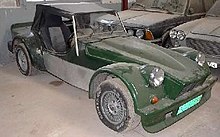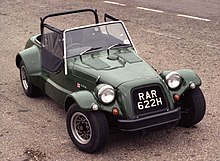Dutton Cars
Dutton Cars in Worthing (West Sussex) was a British manufacturer of kit cars . The company existed from 1970 to 1989 and was at times the world's largest kit car manufacturer.
description
The company was founded by Tim Dutton Wooley and started out in a small workshop, where a number of cars based on the P1 prototype were built, none of which looked like another. The situation stabilized in October 1971 when the first B-Type series model appeared. It was more or less a standard version based on components from the Triumph Herald . The company also moved into a larger factory in Tangmere (West Sussex) .
The B-Type later became the Phaeton . Later versions of the Phaeton were built on Ford Escort components and manufactured until 1989.
In 1979, Dutton announced the Sierra , a station wagon that looked similar to an off-road vehicle and is considered one of the first SUV vehicles. In 1982, the Ford Motor Company released a new model called Sierra and claimed the full naming rights themselves. The dispute went to court and Dutton fought for permission to continue to name their kit cars as the judge ruled that Kit -Cars and assembled cars are two different things. Ford had to bear the cost of the process, and Dutton gained tremendous notoriety through the process. With over 3000 units, the Sierra is one of the best-selling British kit cars. Carlton Automotive in Barnsley temporarily offered a similarly designed kit vehicle with the Commando , which was produced around 400 times.
In 1982 Dutton moved back to Worthing, again in a larger factory building, and at the same time another plant for the manufacture of GRP bodies was opened in Lancing (West Sussex) .
In 1984 the company already had 70 employees and manufactured over 1,000 vehicles. In 1989 the company was closed and the plans sold. A new model called the Maroc , a heavily modified open-body Ford Fiesta , was designed and built by Hacker Engineering in Littlehampton, West Sussex . Initially, the car was offered fully assembled, but the sales prices were too high, and so from 1993 it was also sold as a kit car. The plans were sold to Novus in Bolney (Sussex) and there are still modified versions of this car (as of 2006).
After closing his kit car business, Tim Dutton Wooley worked as a consultant, but returned to the automotive business in 1995. He brought out the Amphibian and Commando models , amphibious vehicles based on the Ford Fiesta and the Suzuki Samurai . One of them also crossed the English Channel .
Dutton kit cars are hard to come by today. Most of the Dutton have already been assembled and are now only available as second-hand vehicles, mostly in a condition in need of restoration. If a dutton is sold as a kit, a donor car is required. Of these, the engine, transmission and many other important components are used. Ford vehicles generally make a good donation car. Many buyers cannibalize donor cars that are no longer ready to drive and use the spare parts to build a new kit car.
In August 2008, Tim Dutton Wooley was convicted of selling amphibious vehicles unsuitable for carrying paying passengers in contravention of the UK's Trade Discriptions Act (1968) .
Models
| Type | Construction period | Remarks |
|---|---|---|
| P1 | 1970-1971 | Car similar to the Lotus 7 on the mechanical basis of the MG Midget . Aluminum body with GRP fenders |
| B-type | 1971-1974 | Based on the Triumph Herald . Body mainly made of GRP. On request: Ford engine |
| B plus | 1974-1977 | Rear axle from the Ford Cortina , but with coil springs. |
| Malaga | 1974-1977. | Front fenders potted with the body |
| Malaga B Plus | 1975-1977 | Front of the Malaga and rear of the B Plus |
| Cantera | 1976-1977 | Coupe version of the Malaga B Plus |
| Phaeton series 1 | 1977-1981 | Redesigned Malaga B Plus. |
| Phaeton series 2 | 1980-1982 | Rear suspension modified to use Cortina springs |
| Phaeton series 3 | 1981-1986 | Modified chassis to accommodate Ford Escort components |
| Phaeton series 4 | 1986-1989 | Modified body with integrated bumpers. |
| B Plus Series 2 | 1989 | B Plus with the body shape of the Phaeton |
| Melos | 1982–1989 (pre-series 1972, 2-seat configuration) | Phaeton chassis with a new body with a more rounded design. 2 + 2 seat configuration |
| Legerra | 1988-1989 | The first button with doors that can be opened |
| Sierra Series 1 | 1980-1984 | Four-seater based on the Ford Escort. Station wagon / off-road vehicle design. An early front-wheel drive SUV. |
| Sierra Series 2 | 1984-1986 | Improved body with some double-coated sheet metal. |
| Sierra series 3 | 1986-1989 | New body but very similar to the Series 2 |
| Sierra Drop Head | 1983-1989 | No roof. There was also a pickup version. |
| Rico | 1984-1989 | Four-seater limousine based on the Ford Escort |
| Rico Shuttle | 1986-1989 | Combined version of the Rico. |
| Beneto | 1989 | SUV version of the Rico |
Technical data (selection)
| model | Construction period | Engine manufacturer | cylinder | Displacement | power | at speed | wheelbase |
|---|---|---|---|---|---|---|---|
| B-type | 1971-1974 | ford | 4 row | 1298 cc | 71 bhp (52 kW) | 6000 min -1 | 2261 mm |
| B Plus / Malaga | 1974-1977 | ford | 6 V | 2994 cc | 138 bhp (101 kW) | 5000 min −1 | 2261 mm |
Web links
- Dutton Owner's Club
- Dutton Amphibian ( Memento of May 8, 2013 in the Internet Archive )
literature
- David Culshaw, Peter Horrobin: The Complete Catalog of British Cars 1895-1975 . Veloce Publishing plc. Dorchester (1999). ISBN 1-874105-93-6 .



